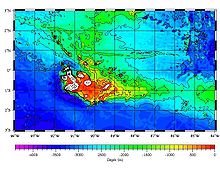Galapagos hotspot

Galapagos Bathymetry by William Chadwick, University of Oregon
|
|
| Country | Ecuador |
|---|---|
| Territory | Galapagos Islands |
| Region | Pacific Ocean |
| Coordinates | 0°22′S 91°33′W / 0.37°S 91.55°WCoordinates: 0°22′S 91°33′W / 0.37°S 91.55°W |
The Galápagos hotspot is a volcanic hotspot in the East Pacific Ocean responsible for the creation of the Galapagos Islands as well as three major aseismic ridge systems, Carnegie, Cocos and Malpelso which are on two tectonic plates. The hotspot is located near the Equator on the Nazca Plate not far from the divergent plate boundary with the Cocos Plate. The tectonic setting of the hotspot is complicated by the Galapagos Triple Junction of the Nazca and Cocos plates with the Pacific Plate. The movement of the plates over the hotspot is determined not solely by the spreading along the ridge but also by the relative motion between the Pacific Plate and the Cocos and Nazca Plates.
The hotspot is believed to be over 20 million years old and in that time there has been interaction between the hotspot, both of these plates, and the divergent plate boundary, at the Galapagos Spreading Centre. Lavas from the hotspot do not exhibit the homogeneous nature of many hotspots; instead there is evidence of four major reservoirs feeding the hotspot. These mix to varying degrees at different locations on the archipelago and also within the Galapagos Spreading Centre.
In 1963, Canadian geophysicist J. Tuzo Wilson proposed the "hotspot" theory to explain why although most earthquake and volcanic activity occurs at plate boundaries, some occurs far from plate boundaries. The theory claimed that small, long-lasting, exceptionally "hot" areas of magma are located under certain points on Earth. These places, dubbed "hotspots," provide localized heat and energy systems (thermal plumes) that sustain long-lasting volcanic activity on the surface. This volcanism builds up seamounts that eventually rise above the ocean current, forming volcanic islands. As the islands slowly moved away from the hotspot, by the motion of sliding plates as described by the theory of plate tectonics, the magma supply is cut, and the volcano goes dormant. Meanwhile, the process repeats all over again, this time forming a new island, on and on until the hotspot collapses. The theory was developed to explain the Hawaiian-Emperor seamount chain, where historic islands could be traced to the northwest in the direction that the Pacific Plate is moving. The early theory put these fixed sources of heat for the plumes deep within the Earth; however, recent research has led scientists to believe that hotspots are actually dynamic, and able to move on their own accord.
...
Wikipedia
